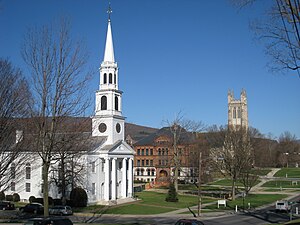Williamstown, Massachusetts
| Williamstown, Massachusetts | ||
|---|---|---|
| Town | ||

Main Street
|
||
|
||
| Motto: "The Village Beautiful" | ||
 Location in Berkshire County and the state of Massachusetts. |
||
| Coordinates: 42°42′43″N 73°12′15″W / 42.71194°N 73.20417°WCoordinates: 42°42′43″N 73°12′15″W / 42.71194°N 73.20417°W | ||
| Country | United States | |
| State | Massachusetts | |
| County | Berkshire | |
| Settled | 1749 | |
| Incorporated | 1765 | |
| Government | ||
| • Type | Open town meeting | |
| Area | ||
| • Total | 46.9 sq mi (121.4 km2) | |
| • Land | 46.8 sq mi (121.1 km2) | |
| • Water | 0.1 sq mi (0.3 km2) | |
| Elevation | 638 ft (194 m) | |
| Population (2010) | ||
| • Total | 7,754 | |
| • Density | 166/sq mi (64.0/km2) | |
| Time zone | Eastern (UTC-5) | |
| • Summer (DST) | Eastern (UTC-4) | |
| ZIP code | 01267 | |
| Area code(s) | 413 | |
| FIPS code | 25-79985 | |
| GNIS feature ID | 0619430 | |
| Website | www |
|
Williamstown is a town in Berkshire County, in the northwest corner of Massachusetts, United States. It shares a border with Vermont to the north and New York to the west. It is part of the Pittsfield, Massachusetts Metropolitan Statistical Area. The population was 7,754 at the 2010 census. A college town, it is home to Williams College, the Clark Art Institute and the Tony-awarded Williamstown Theatre Festival, which runs every July and August.
Originally called West Hoosac, the area was first settled in 1749. Prior to this time its position along the Mohawk Trail made it ideal Mohican hunting grounds. Its strategic location bordering Dutch colonies in New York led to its settlement, because it was needed as a buffer to stop the Dutch from encroaching on Massachusetts. Fort West Hoosac, the westernmost blockhouse and in Massachusetts, was built in 1756. The town was incorporated in 1765 as Williamstown according to the will of Col. Ephraim Williams, who was killed in the French and Indian War. He bequeathed a significant sum to the town on the condition that it were named after him and started a free school. In 1791, the school opened, but only lasted a short time as a free school before becoming Williams College in 1793.
The primary industry was agriculture, particularly dairy farming, sheep herding and wool production. Sawmills and gristmills operated by water power at the streams. With the Industrial Revolution larger mills were added, including the Walley Mill and Williamstown Manufacturing Company (Station Mill), both of which produced textiles. The A. Loop & Company (Water Street Mill) produced twine. With the opening of the railroad, tourists arrived. Several inns and hotels were established, including the Idlewild Hotel and Greylock Hotel. In the late 1930s and 1940s, E. Parmelee Prentice and his wife Alta, the daughter of John D. Rockefeller, created Mount Hope Farm. With a mansion designed by James Gamble Rogers, it was one of the outstanding experimental farms in the country. Today, it belongs to Williams College, which remains the largest employer in town.
...
Wikipedia

